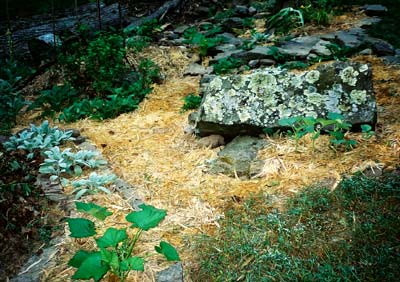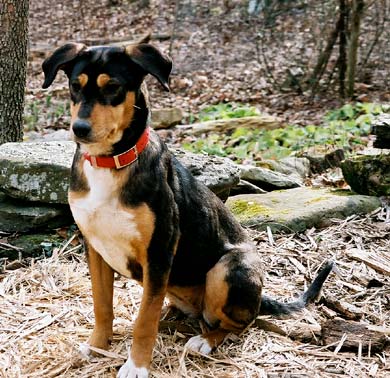
Early July in the Pumpkin Patch
I fell for a warty, peach-colored pumpkin at the Fayetteville Farmer’s Market last fall. The knobby growths and pale color attracted my imagination as the multitude of pumpkins jostled for attention on the long flatbed trailer. The pale color and the unusual texture pleased me in the same manner that I find the nubs seen in raw silk fabric add a pleasing texture to a smooth silk fabric. I circled the display searching for the perfect pumpkin to bring home to Cedar Hill. When I asked the farmer about the name of this variety, he pulled out the catalogue and pointed to Galeuse d’Eysines adding that they are delicious pumpkins encouraging me to steam it and to eat it.
I discovered that my adopted pumpkin was from Eysines, France introduced in 1883. This unique pumpkin, Cucurbita maxima, was also called Warted Sugar Marrow. I was sure my pumpkin was no hybrid with a pedigree like this! I had fantasies of growing my own next spring.

Sugar Marrow Pumpkin from Eysines, France introduced in 1883
I displayed the Galeuse d’Eysines in several spots in the house that fall and winter appraising the personality and charm of this new acquaintance. By early spring, I had moved it to a spot outside near the front bench. As the pumpkin began to sink in on itself, I discovered that Shyla, our youngest adopted mutt, had enjoyed the texture in her own way. Shyla had shredded skin and the inner membranes containing the seeds. I found seeds and membranes scattered near the rock wall that marks our first garden bed. I vaguely hoped some might sprout, but had no expectations.
Today we have three rambling pumpkin vines climbing over and around our former compost area. Circumstantial evidence led me to believe that those wandering pumpkin seeds did sprout! I noticed the small pumpkin plants nestled near the rock wall before the deer did. I quickly transplanted them to a sunny spot below the main garden where they will be able to spread their tendrils far and wide before fall ends their adventure. I do not want to “count my pumpkins before they hatch”, but I am extremely hopeful that this will be the beginning of a beautiful relationship. Some of the immature pumpkins are the size of golfballs–smooth with no warts yet. When I wrote this last week I was convinced that I had the wonderful warty pumpkin growing.
Today I believe that I jumped to conclusions! The pumpkins a bigger, still white, and have no warts. Among my scrapbook items for last fall I found a label for a “White Carving Pumpkin” from Bottomleys Evergreens in North Carolina and a product number to go with that pumpkin. I searched their online catalogue to locate the botanical name of the thirty pumpkins glowing in our garden but found no white pumpkins. I have emailed them about my dilemma and will report any results. Jeanne and I have resolved to buy seed for the Warty Sugar Marrow pumpkin for next year!
Saving seeds from hybrid plants is risky because the seeds are often not true to form. Seeds from non-hybrid plants, or open-pollinated seeds (sometimes called heirloom seeds), are reliable in producing plants and fruit like the parent. We have transformed our garden this year with our sweat and hand tools to make room for more edible plants. All our new seeds will be open-pollinated so we can save our own seeds for the future!
Our previous raised beds did not provide room for extreme ramblers like pumpkins, gourds and watermelons–all of which we are trying this year. Each of these varieties displays an affection for hot days and nights. I am energized by the “lust for life” of the cucurbit family. The Miniature White Cucumbers we planted are so prolific that I need to eat one every time I open the refrigerator. Picked at three inches long and chilled in the solar-powered refrigerator they are a perfect summer treat. With a sweet cucumber flavor and skin as tender as an apple, this cucumber is best eaten raw and I do.

Shyla, the Rambunctious Pumpkin Shredder
A great source for open pollinated seeds is Seed Saver’s Exchange, 3094 North Winn Road, Decorah, Iowa 52101, 563-382-5990, www.seedsavers.org. All the seeds I have mentioned here were purchased from Seed Savers including:
Birdhouse gourd: Lagenaria siceraria
Watermelon: Crimson Sweet, Citrullus Lantatus
Miniature White Cucumbers, Cucumis sativus
I was challenged to understand which of these might cross-pollinate and produce an undesired, inedible hybrid. Seed Savers recommended The Compleat Squash: A Passionate Grower’s Guide to Pumpkins, Squashes and Gourds by Amy Goldman (2004). The author indicates that squashes will not crossbred with melons and cucumbers. However, squashes in the same species do cross with one another. We have kept it simple this year by growing only one variety of squash.
The squash, watermelon and cucumbers were purchased seed. Our Warted Sugar Marrow pumpkin was planted by a rambunctious canine and nurtured by Mother Nature until Paula discovered it sprouting in deer territory. It has been a team effort with Jeanne carrying water to the pumpkin patch occasionally. All of these are rampant growers with big leaves and curling tendrils reaching for support. Some of the pumpkin vines are twelve feet long and still growing! I have developed an intimate relationship with each plant. I find myself infected by their “lust for life” and energized by their exuberance. Thank you, Shyla, for your part in this story!

